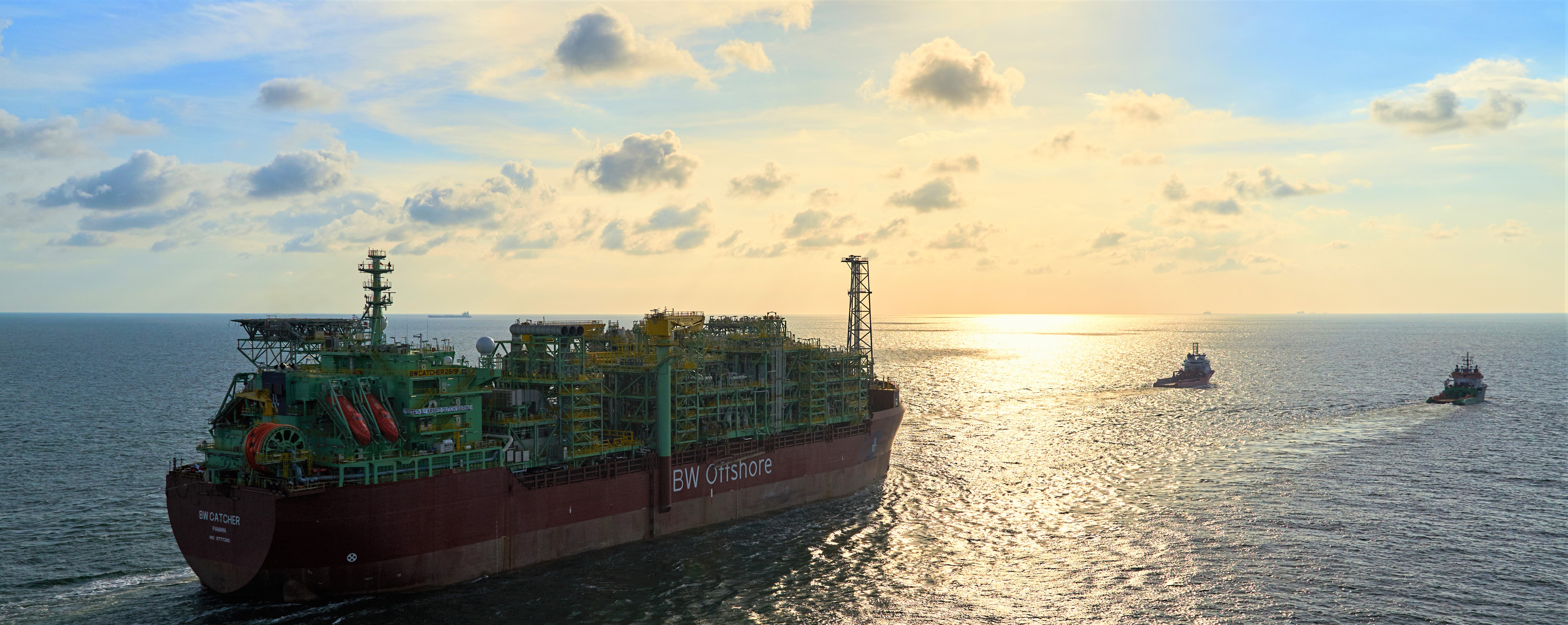New Ventures and Technology
Building a substantial and growing position in offshore renewable energy infrastructure.
BW Offshore is committed to contributing to the energy transition by developing low-carbon offshore energy production solutions. We are applying four decades of experience in the energy sector, with extensive innovation and financing capabilities, to develop floating energy solutions and offshore renewable power production at industrial scale.
Political and financial commitments to reducing the carbon intensity of global energy systems continue to gain momentum, using solutions such as floating wind, hydrogen, ammonia and carbon capture.
For us, this includes combining existing FPSO and floating wind capabilities to develop and deploy clean offshore energy production and develop new adjacent business areas. These may include low-carbon FPSOs powered by floating wind or floating gas-to-power plants.
BW Offshore are looking into several areas of renewable energy that fit well with our existing business of operating FPSOs, and where we believe we can leverage already existing capabilities within our organisation.

Carbon Capture and Storage (CCS)
Net Zero by 2050 – threat or opportunity? The only certainty is that “business as usual” is not an option, and whilst few would disagree with the necessity and urgency of implementing the strategy set out by the UN Intergovernmental Panel on Climate Change, it’s easy to become focused on the potential negative implications for a company with a history steeped in the fossil fuel industry. Operators who continue to emit large quantities of CO2 face increasing penalties – emissions taxation is already a reality in Europe, Australia and Canada and other regions are expected to follow suit, and 2021 saw unprecedented rises in cost per tonne in some of those established regimes. And, in addition to direct penalisation, any company following an unmitigated strategy of fossil fuel development will find it increasingly difficult to secure project finance.
But as fiscal pressure on emitters grows, so do opportunities for those positioned to provide cost-effective solutions for reduction or management of emissions. The demand for oil and gas is not forecast to diminish in the short term, so exploration and production companies will look for ways to either avoid or manage CO2 emissions produced by upstream operations. The bulk of such emissions come from power generation, and electrification – replacement of local gas turbine generators by imported power – is one reduction mechanism, but CCS – Carbon Capture and Storage – is likely to be more cost-effective for remoter developments. In fact, case studies conducted over the past 18 months by the technology team, in conjunction with leading carbon capture technology providers, have demonstrated that it’s already possible to integrate power generation CCS into a new FPSO-based field development at an overall cost of capture that’s lower than the prevalent CO2 emission tax rate. And that’s without factoring further policy-driven taxation increases, or reductions in cost of capture technology.
While our industry does not change drastically overnight, we are always looking to the future, and committed to confirming our purpose: to engineer offshore production solutions to progress the future of energy.
Opportunities in the CCS space don’t stop with management of emissions from our own operations – whilst for many offshore oil & gas developments it’s expected to be possible to dispose of captured CO2 locally, often this isn’t the case for onshore industrial emitters, and a whole value chain is expected to develop around the capture, transport and disposal of CO2 at locations remote from the point of emission. The BW group is perhaps uniquely positioned to service the entire downstream component of this value chain, from liquid CO2 transport by gas carrier vessel, through to disposal reservoir acquisition and management – and with BW Offshore playing a central role injecting the CO2 using a new variation on the FPSO concept: the Floating Injection Hub. The technology team have started development work on this concept, which essentially reverses the conventional FPSO process – we receive liquid CO2 transported from source by shuttle carrier vessel, store it in specially designed tanks in the injection hub hull, and continuously inject it into a suitable depleted oil & gas reservoir.
BW Offshore’s CCS development effort continues through 2022 and 2023 on two fronts: firstly, we are ready to offer power generation carbon capture as an add-on to conventional new-build FPSOs - and we continue to engage with tender processes to actively promote this capability towards clients, whilst monitoring developments in capture technology to identify opportunities for further cost improvement. Secondly, we continue our exploration of adjacent business opportunities through a proof-of-concept study to establish a business case for the floating injection hub concept.
For a dynamic, versatile floating production solution provider committed to progressing the future of energy, the Net Zero 2050 opportunities are clear.

Gas to Power
Together with BW LNG, we develop and market various gas to power concepts to provide power to coastal areas globally.
Electrification is happening faster than ever – growing at a faster rate than overall energy demand. The share of electricity in final global energy demand is set to double from 19% to 38% within the next 30 years.
The power sector is set to overtake oil & gas as the largest energy investment area in the next decade – mainly driven by renewables. Gas plays an important role in the move to a low-carbon society. It serves as a transition fuel, a replacement for higher polluting fossil fuels, and will complement/balance renewables that do not yet have grid stability. BW Offshore is also working to reduce emissions from gas by CCS and other technologies like combined cycle power generation. LNG assumes a larger role globally including developing economies, but gas from existing fields to power is also increasingly attractive.
BW Offshore and BW LNG also work together in collaboration with other partners, to develop and market solutions for gas to power.

Hydrogen and Ammonia
Hydrogen and Ammonia are forecasted to enable significant emissions reductions in power, transportation, and heating sectors. In 2022, BW Offshore commenced Proof of Concept phase for an Offshore Green Ammonia FPSO powered by floating wind. In parallel, we are developing concepts for nearshore green ammonia, and monitoring technology progress to enable offshore blue ammonia production combined with carbon capture and storage. But why focus on ammonia?
Transitioning to production of either hydrogen or ammonia might be seen as a natural step for the offshore energy industry. Whilst today most commercial hydrogen is “grey,” meaning it’s manufactured via the emissions-intensive natural gas reforming method, technology is advancing to enable production of low-carbon “blue” and zero-carbon “green” hydrogen. The former combines traditional natural gas reforming with CCS - capture and sequestration of the CO2 emissions - and the latter uses electricity to split water through a process known as electrolysis. The raw resources for these diverse routes exist in abundance in the offshore environment – natural gas to feed the blue process and depleted oil & gas reservoirs to store produced CO2, and almost limitless wind and wave energy that can be converted to renewable electricity to power green electrolysis.
What makes ammonia manufacture particularly attractive to a floating production specialist such as BW Offshore, are the parallels with FPSO-based crude oil production and export, and the potential for leveraging the advantages of the FPSO concept in this new market.
For all its benefits, there are challenges to the global adoption of hydrogen as a fuel. As a gas, it has a very low volumetric energy content – about one third that of natural gas – and so to enable economic transportation in “pure” form, it must either be compressed to very high pressures or liquified by cooling to very low temperatures - either of which consume large amounts of energy and significantly reduce the efficiency of the production process. It’s extremely flammable and explosive, and as the smallest and lightest of all elements, has a highly fugitive nature, which presents challenges to the design, construction and maintenance of containment systems such as tanks and pipelines.
Conversion of hydrogen into forms that can be more efficiently and safely stored, handled and transported is thus desirable, and this can be achieved by combining the pure form with other substances to produce “carrier molecules”. Such carriers include LOHC (liquid organic hydrogen carriers) and ammonia; formed at the point of hydrogen production, they are transported as a stable liquid, and processed to release the hydrogen at point of consumption. Ammonia is particularly versatile in this respect, since as well as acting as a carrier, it’s also a zero-carbon fuel – the shipping industry in particular is looking to ammonia as the fuel of the future, and several of the major manufacturers of marine propulsion engines are actively developing ammonia-fuelled product lines.
What makes ammonia manufacture particularly attractive to a floating production specialist such as BW Offshore, are the parallels with FPSO-based crude oil production and export, and the potential for leveraging the advantages of the FPSO concept in this new market.
By taking an offshore resource in the form of either natural gas or wind energy and converting it to hydrogen, which we then combine with another abundant natural resource – nitrogen from air – to produce liquid ammonia, which is stored in low-pressure refrigerated tanks in the FPSO’s hull and periodically offloaded, we can utilise the established fleet of ammonia carrier vessels to transport our product to an expanding market. Given the shipping industry’s focus on ammonia fuel, there is even the possibility of direct offshore bunkering of trading vessels. Stranded gas fields and offshore wind can in this way be monetised within the low/zero carbon energy chain, and without the need for access to a pipeline network.
BW Offshore is well positioned to design, build and operate an offshore or nearshore ammonia FPSO, with support from group members BW Ideol (renewable energy supply) and BW LPG (liquefied gas storage and transport.) In conjunction with development partners and leading ammonia process licensors and electrolyser manufacturers, our offshore proof of concept study is progressing. The study will conclude during 2022 with an assessment of the business case and recommendations for progression to FEED.
While our industry does not change drastically overnight, we are always looking to the future, and committed to confirming our purpose: to engineer offshore production solutions to progress the future of energy.
